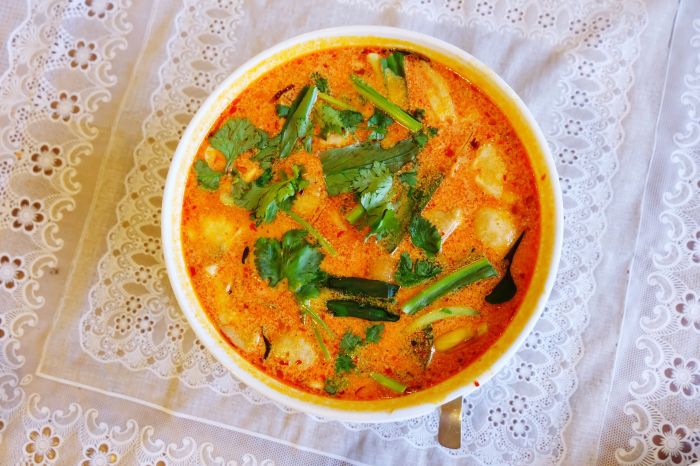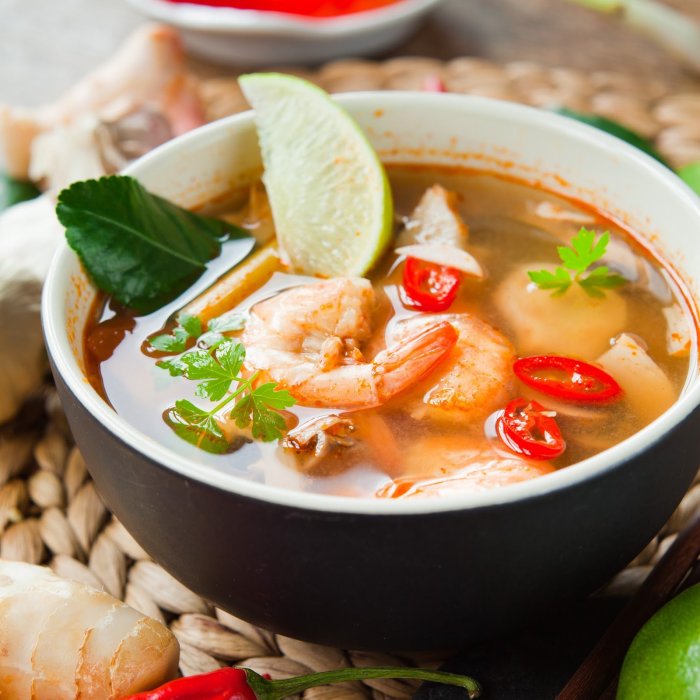Tom Yum soup, a culinary masterpiece from Southeast Asia, tantalizes taste buds with its exquisite blend of sour, spicy, and aromatic flavors. Its origins, ingredients, health benefits, and cultural significance make it a dish that embodies the vibrant tapestry of Southeast Asian cuisine.
From its humble beginnings in Thailand, tom yum soup has evolved into a global culinary sensation, captivating hearts and palates worldwide. Its versatility and adaptability have allowed it to transcend geographical boundaries, inspiring countless variations and adaptations that showcase the creativity and diversity of the culinary world.
Origin and History

Tom Yum soup, a culinary masterpiece of Thailand, has a rich history steeped in cultural significance and regional variations.
Its origins trace back to the 14th century, during the Sukhothai period. It is believed to have evolved from a simple broth made with tamarind, lemongrass, and chili peppers, which were readily available ingredients in the region. Over time, the soup evolved, incorporating influences from neighboring countries such as Laos and Cambodia.
Regional Variations
Tom Yum soup has several regional variations, each with its own unique flavors and ingredients:
- Tom Yum Goong: The most popular variation, made with shrimp, lemongrass, galangal, kaffir lime leaves, and chili peppers.
- Tom Yum Gai: A variation made with chicken, typically using the same ingredients as Tom Yum Goong.
- Tom Yum Po Taek: A spicy and sour variation made with fish maw (the dried swim bladder of fish), which gives it a unique texture.
Ingredients and Flavors: Tom Yum Soup
Tom Yum soup is renowned for its complex and harmonious blend of flavors, achieved through a careful selection of essential ingredients. These ingredients contribute unique flavor profiles that work together to create the distinctive taste of Tom Yum soup.
At its core, Tom Yum soup relies on a sour base, typically provided by lime juice or tamarind paste. This sourness is balanced by the spiciness of chili peppers, which can range from mild to intensely hot depending on personal preference.
Aromatic ingredients like galangal, lemongrass, and kaffir lime leaves add depth and complexity to the flavor profile.
Essential Ingredients
- Galangal: A type of ginger with a unique, earthy flavor that adds depth to the soup.
- Lemongrass: A fragrant herb that provides a citrusy and refreshing note.
- Kaffir Lime Leaves: Aromatic leaves that add a distinctive citrus and floral flavor.
- Lime Juice or Tamarind Paste: Provides the sour base of the soup.
- Chili Peppers: Adds spiciness and heat, varying in intensity based on preference.
Variations
While the core ingredients remain consistent, Tom Yum soup exhibits regional variations across different parts of Thailand and neighboring countries. In Northern Thailand, for example, the soup often incorporates fermented pork sausage, while in Southern Thailand, coconut milk is sometimes added for a richer flavor.
Health Benefits
Tom Yum soup is not only delicious but also offers a range of potential health benefits.
The soup is rich in antioxidants, which help protect the body against damage caused by free radicals. These antioxidants come from ingredients such as lemongrass, galangal, and kaffir lime leaves.
Anti-inflammatory Properties
Tom Yum soup also has anti-inflammatory properties. This is due to the presence of compounds such as gingerol in ginger and capsaicin in chili peppers. These compounds have been shown to reduce inflammation in the body.
If you’re craving a spicy and sour treat but want to keep it keto-friendly, tom yum soup is a great option. The broth is packed with flavor, and the addition of cottage cheese here adds a creamy richness that makes it even more satisfying.
Top it off with some fresh cilantro and lime wedges, and you’ve got a delicious and guilt-free meal.
Cultural Significance
Tom Yum soup holds a profound cultural significance in Thailand and other Southeast Asian countries, reflecting the region’s culinary traditions and cultural values.
In Thailand, Tom Yum soup is considered a national dish and a symbol of Thai cuisine. It is served at festivals, celebrations, and everyday meals, representing the country’s vibrant and flavorful culinary heritage.
In Daily Life
Tom Yum soup is a staple in Thai households, often prepared as a quick and comforting meal. Its versatility allows for variations based on personal preferences and available ingredients, making it a beloved dish for all ages.
In Festivals and Celebrations
Tom Yum soup plays a significant role in Thai festivals and celebrations. It is commonly served at Songkran, the Thai New Year, and Loy Krathong, the festival of lights. During these occasions, Tom Yum soup symbolizes renewal, good fortune, and the coming together of families and communities.
Variations and Adaptations
Tom Yum soup has a diverse array of regional variations, each boasting unique ingredients, flavors, and presentations.
Regional Variations
In Thailand, the birthplace of Tom Yum, regional variations include:
-
-*Tom Yum Goong
The classic version made with shrimp and a clear broth.
-*Tom Yum Gai
A variation with chicken instead of shrimp.
-*Tom Yum Po Taek
A spicy and sour version from the Isan region, often featuring bamboo shoots and wood ear mushrooms.
-*Tom Yum Pak Boong
A variation with morning glory greens, creating a vibrant and flavorful soup.
Adaptations for Different Cuisines
As Tom Yum soup gained popularity worldwide, it has been adapted to suit different cuisines and preferences:
-
-*Vietnamese Canh Chua
A Vietnamese adaptation with a tangy broth, often using tamarind as a souring agent.
-*Chinese Tom Yum
A fusion dish that combines Chinese flavors with the sour and spicy elements of Tom Yum.
-*Western Tom Yum
A variation that incorporates Western ingredients, such as bell peppers and tomatoes.
Creative Adaptations, Tom yum soup
Modern culinary innovations have given rise to creative adaptations of Tom Yum soup:
-
-*Tom Yum Pizza
A fusion dish that combines the flavors of Tom Yum with a pizza base.
-*Tom Yum Burgers
Burgers with a Tom Yum-infused patty and toppings.
-*Tom Yum Sorbet
A refreshing sorbet that captures the essence of the soup in a frozen treat.
Cooking Techniques

Crafting Tom Yum soup is an art that requires meticulous attention to detail. By employing traditional cooking methods and utilizing fresh, high-quality ingredients, you can achieve a harmonious balance of flavors and aromas that will tantalize your taste buds.
Step-by-Step Guide
- Prepare the Broth:Begin by simmering lemongrass, galangal, and kaffir lime leaves in a pot of water or chicken broth. This aromatic base forms the foundation of the soup.
- Add the Chili Paste:Once the broth is flavorful, stir in a generous amount of Tom Yum paste. This spicy blend imparts the soup’s signature heat and tang.
- Simmer the Vegetables:Add sliced mushrooms, tomatoes, and onions to the broth and simmer until tender. These vegetables contribute sweetness, acidity, and texture to the soup.
- Incorporate the Protein:Choose your preferred protein, such as shrimp, chicken, or tofu, and add it to the soup. Simmer gently until cooked through.
- Balance the Flavors:Taste the soup and adjust the seasonings as needed. Add fish sauce for saltiness, lime juice for acidity, and sugar for sweetness. Aim for a harmonious balance of flavors.
- Garnish and Serve:Garnish the soup with fresh cilantro, green onions, and a squeeze of lime juice. Serve piping hot with rice or noodles.
Tips and Tricks
- Use fresh, ripe ingredients to enhance the soup’s flavor and nutritional value.
- Don’t overcook the vegetables; they should retain their vibrant color and texture.
- Adjust the spice level to your preference. Use more or less chili paste to create the desired heat.
- Experiment with different proteins and vegetables to create unique variations of Tom Yum soup.
- Serve the soup immediately for the best flavor and aroma.
Nutritional Value
Tom Yum soup is a nutritious dish packed with various essential nutrients. A typical serving of 240 grams provides approximately:* Calories: 150-200
Protein
15-20 grams
Fat
10-15 grams
Carbohydrates
20-25 gramsIt is also a good source of:* Vitamins: Vitamin A, Vitamin C, Vitamin B6, Folate
Minerals
Potassium, Magnesium, Phosphorus, Iron
Impact of Ingredients and Preparation Methods
The nutritional value of Tom Yum soup is influenced by the choice of ingredients and preparation methods.*
-*Use of Fresh Ingredients
Using fresh herbs, vegetables, and lean protein sources ensures a higher nutrient content compared to processed or canned ingredients.
-
-*Minimal Use of Oil
Opting for lean protein sources and stir-frying instead of deep-frying helps reduce fat content while preserving the dish’s flavors.
-*Reduced Salt
Seasoning with herbs and spices instead of excessive salt promotes a healthier sodium intake.
Recommendations for Healthier Tom Yum Soup
To make Tom Yum soup healthier without compromising its authentic flavors, consider the following recommendations:*
-*Use Whole-Wheat Noodles
Substitute rice noodles with whole-wheat noodles for added fiber and nutrients.
-
-*Add More Vegetables
Include a variety of fresh vegetables, such as carrots, celery, and mushrooms, to increase the soup’s nutrient density.
-*Choose Lean Protein
Opt for lean protein sources like chicken or tofu to reduce fat content.
-*Reduce Sugar
Limit the addition of sugar or honey to balance the soup’s sweetness.
-*Use Low-Sodium Broth
Use low-sodium broth or water to control the soup’s sodium content.
Food Pairing
Tom Yum soup’s vibrant flavors make it a versatile culinary partner. Its sour, spicy, and aromatic profile complements a wide range of dishes, enhancing their taste and elevating the overall dining experience.
Traditionally, Tom Yum soup is served as a standalone dish or as an accompaniment to steamed rice. However, it can also be paired with various appetizers, main courses, and desserts to create a complete and satisfying meal.
Appetizers
- Spring Rolls:Crispy spring rolls filled with vegetables or meat provide a textural contrast to the soup’s broth.
- Satay Skewers:Grilled chicken or beef skewers marinated in a savory sauce add a smoky and flavorful dimension.
Main Courses
- Pad Thai:A stir-fried noodle dish with a sweet and tangy sauce complements the spicy and sour notes of Tom Yum soup.
- Green Curry:A rich and creamy curry with a hint of coconut milk balances the heat of the soup.
Desserts
- Mango Sticky Rice:Sweet and sticky rice topped with ripe mango provides a refreshing contrast to the soup’s savory flavors.
- Coconut Ice Cream:The creamy sweetness of coconut ice cream helps cool down the palate after the spicy soup.
Wrap-Up

In conclusion, tom yum soup is not merely a dish; it is a culinary journey that transports us to the heart of Southeast Asian flavors. Its vibrant colors, tantalizing aromas, and exquisite taste have made it a beloved delicacy, enjoyed by food enthusiasts around the globe.
As we continue to explore the culinary depths of this iconic soup, we uncover new layers of complexity and delight, ensuring its enduring legacy as a culinary masterpiece.








